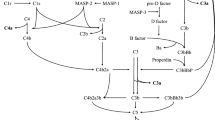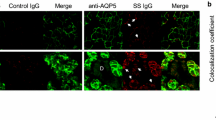Abstract
Sjögren’s syndrome (SS) is a prototypical systemic autoimmune disease, where autoimmune processes lead to the dysfunction of the exocrine glands. The key feature of the disease is autoimmune exocrinopathy, causing reduced tear secretion and subsequent keratoconjunctivitis sicca (KCS). The aim of this study was to investigate the connection between the presence of autoantibodies to lachrymal gland antigens and the reduced tear production in patients with primary SS. Ninety-nine patients, 90 women and 9 men, were investigated in the study. Twenty healthy young women served as controls. Enzyme-linked immunosorbent assay (ELISA) and Western blotting were applied to detect autoantibodies to antigen fractions prepared from the human lachrymal gland membrane and cytosolic fractions. Autoantibodies of the IgG, IgA and IgM isotypes to the lachrymal membrane and cytosolic fractions were detected in about one third (27%) of the patients with primary SS. IgA antobodies to the membrane and cytosolic fractions occurred most frequently in SS patients. A significant difference was found in the presence of IgA antibodies to the membrane lachrymal fraction between patients and controls given in ELISA indices (1.23 ± 0.3 vs 1 ± 0.19, p < 0.001). IgG, IgA, and IgM isotypes of autoantibodies directed to the membrane lachrymal fraction of 200–180, 120–116, 80–70, 58, 50, 48.5, 40 and 28.8 kDa were also identified in patients. Membrane IgG antibody levels showed a positive correlation (R = 0.998; p = 0.045) with the clinical loss of secretory function (Schirmer’s test values). Positive correlation was found between membrane IgM and anti-SS-A levels (R = 0.962; p = 0.038) and also between cytosolic IgM antibodies and anti-SS-A levels (R = 0.982; p = 0.018). IgG, IgA and IgM types of autoantibodies may play a role in the development of the impaired lachrymal secretion and therefore may be involved in the pathogenesis of KCS.


Similar content being viewed by others
References
Manthorpe R (2002) Sjögren’s syndrome criteria. Ann Rheum Dis 61:482–484
Jonsson R, Brokstad K (2001) Sjögren’s syndrome. In: Austen F, Atkinson C (eds) Samter’s immunologic diseases, 6th edn. Lippincott Williams & Wilkins, Philadelphia, pp 495–504
Tengner P, Halse AK, Haga HJ et al (1998) Detection of anti-Ro/SSA and anti-La/SSB autoantibody-producing cells in salivary glands from patients with Sjogren’s syndrome. Arthritis Rheum 41:2238–2248
Kino-Ohsaki J, Nishimori I, Morita M et al (1996) Serum antibodies to carbonic anhydrase I and II in patients with idiopathic chronic pancreatitis and Sjögren’s syndrome. Gastroenterology 110:1579–1586
Feist E, Kuckelkorn U, Dorner T et al (1999) Autoantibodies in primary Sjogren’s syndrome are directed against proteasomal subunits of the alpha and beta type. Arthritis Rheum 42:697–702
Haneji N, Nakamura T, Takio K et al (1997) Identification of alpha-fodrin as a candidate autoantigen in primary Sjogren’s syndrome. Science 276:604–607
Ruffatti A, Ostuni P, Grypiotis P et al (2004) Sensitivity and specificity for primary Sjogren’s syndrome of IgA and IgG anti-alpha-fodrin antibodies detected by ELISA. J Rheumatol 31:504–507
Szanto A, Csipo I, Zeher M (2005) Sensitivity and specificity of anti-alpha-fodrin antibodies in primary Sjogren’s syndrome. J Rheumatol 32:197
Bacman S, Perez Leiros C, Sterin-Borda L et al (1998) Autoantibodies against lacrimal gland M3 muscarinic acethylcoline receptors in patients with primary Sjögren’s syndrome. Investig Ophthalmol Vis Sci 39:151–156
Bacman S, Sterin-Borda L, Camusso JJ et al (1996) Circulating antibodies against rat parotid gland M3 muscarinic receptors in primary Sjogren’s syndrome. Clin Exp Immunol 104:454–459
Markusse HM, Otten HG, Vroom TM et al (1993) Rheumatoid factor isotypes in serum and salivary fluid of patients with primary Sjogren’s syndrome. Clin Immunol Immunopathol 66:26–32
Esch TR (2001) Pathogenetic factors in Sjogren’s syndrome: recent developments. Crit Rev Oral Biol Med 12:244–251
Zeher M, Szodoray P, Gyimesi E et al (1999) Correlation of increased susceptibility to apoptosis of CD4+ T cells with lymphocyte activation and activity of disease in patients with primary Sjogren’s syndrome. Arthritis Rheum 42:1673–1681
Tsubota K, Saito I, Miyasaka N (1994) Granzyme A and perforin expressed in the lacrimal glands of patients with primary Sjögren’s syndrome. Am J Ophthalmol 117:120–121
Jonsson R, Klareskog L, Bäckman K et al (1987) Expression of HLA-D locus (DP, DQ, DR) coded antigens, β2-microglobulin, and the interleukin 2 receptor in Sjögren’s syndrome. Clin Immunol Imminopathol 45:235–243
Vitali C, Bombardieri S, Jonsson R et al (2002) European Study Group on Classification Criteria for Sjögren’s syndrome. Classification criteria for Sjogren’s syndrome: a revised version of the European criteria proposed by the American-European Consensus Group. Ann Rheum Dis 61:554–558
Bradford MM (1976) A rapid and sensitive method for the qualification of microgram quantites of protein utilizing the principle of protein-dye binding. Anal Biochem 72:248–254
Molnar I, Kaczur V, Boros A et al (1995) IgA autoantibodies against human eye muscle antigen detected by western blotting and immunohistochemical methods in Graves’ disease. J Endocrinol Invest 18:408–414
Towbin H, Staehelim T, Gordon J (1979) Electrophoretic transfer of proteins from polyacrylamide gels to nitrocellulose sheets: procedure and some applications. Proc Natl Acad Sci USA 76:4350–4354
Roland J, Hans-Jacob H, Tom PG (2000) Current concepts on diagnosis, autoantibodies and therapy in Sjögren’s syndrome. Scand J Rheumatol 29:341–348
Jabs DA, Lee B, Whittum-Hudson JA et al (2000) Th1 versus Th2 immune responses in autoimmune lacrimal gland disease in MRL/Mp mice. Investig Ophthalmol Vis Sci 41:826–831
Manganelli P, Quaini F, Andreoli AM et al (1997) Quantitative analysis of apoptosis and bcl-2 in Sjögren’s syndrome. J Rheumatol 24:1552–1557
Ohlsson M, Jonsson R, Brokstad KA (2002) Subcellular redistribution and surface exposure of the Ro52, Ro60 and La48 autoantigens during apoptosis in human ductal epithelial cells: a possible mechanism in the pathogenesis of Sjögren’s syndrome. Scand J Immunol 56:456–469
Casciola-Rosen LA, Anhalt G, Rosen A (1994) Autoantigens targeted in systemic lupus erythematosus are clustered in two populations of surface structures on apoptotic keratinocytes. J Exp Med 179:1317–1330
Kuwana M, Okano T, Ogawa Y et al (2001) Autoantibodies to the amino-terminal fragment of α-fodrin expressed in glandular epithelial cells in patients with Sjögren’s syndrome. J Immunol 167:5449–5456
Acknowledgements
This work was funded by The National Research Fund, Hungary (OTKA: K60534 and K42631) and by the Bolyai János academic research fellowship for Peter Szodoray.
Author information
Authors and Affiliations
Corresponding author
Additional information
Peter Szodoray and Katalin Koczok contributed equally to this work.
Rights and permissions
About this article
Cite this article
Szodoray, P., Koczok, K., Szanto, A. et al. Autoantibodies to novel membrane and cytosolic antigens of the lachrymal gland in primary Sjögren’s syndrome. Clin Rheumatol 27, 195–199 (2008). https://doi.org/10.1007/s10067-007-0678-y
Received:
Revised:
Accepted:
Published:
Issue Date:
DOI: https://doi.org/10.1007/s10067-007-0678-y




